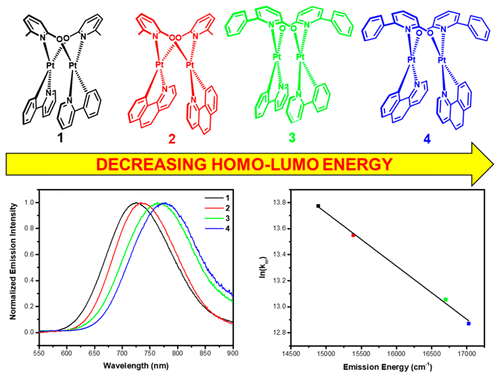当前位置:
X-MOL 学术
›
Inorg. Chem.
›
论文详情
Our official English website, www.x-mol.net, welcomes your feedback! (Note: you will need to create a separate account there.)
Excited-State Processes of Cyclometalated Platinum(II) Charge-Transfer Dimers Bridged by Hydroxypyridines
Inorganic Chemistry ( IF 4.6 ) Pub Date : 2018-01-16 00:00:00 , DOI: 10.1021/acs.inorgchem.7b02736 Arnab Chakraborty 1 , James E. Yarnell 1 , Roger D. Sommer 1 , Subhangi Roy 1 , Felix N. Castellano 1
Inorganic Chemistry ( IF 4.6 ) Pub Date : 2018-01-16 00:00:00 , DOI: 10.1021/acs.inorgchem.7b02736 Arnab Chakraborty 1 , James E. Yarnell 1 , Roger D. Sommer 1 , Subhangi Roy 1 , Felix N. Castellano 1
Affiliation

|
A series of four anti-disposed dinuclear platinum(II) complexes featuring metal–metal-to-ligand charge-transfer (MMLCT) excited states, bridged by either 2-hydroxy-6-methylpyridine or 2-hydroxy-6-phenylpyridine and cyclometalated with 7,8-benzoquinoline or 2-phenylpyridine, are presented. The 2-hydroxypyridine bridging ligands control intramolecular d8–d8 metal–metal σ interactions, affecting the frontier orbitals’ electronic structure, resulting in marked changes to the ground- and excited-state properties of these complexes. Three of these molecules possess reversible one-electron oxidations in cyclic voltammetry experiments as a result of strong intramolecular metallophilic interactions. In this series of molecules, X-ray crystallography revealed Pt–Pt distances ranging between 2.815 and 2.878 Å; the former represents the shortest reported metal–metal distance for platinum(II) dimers possessing low-energy MMLCT transitions. All four molecules reported here display visible absorption bands beyond 500 nm and feature MMLCT-based red photoluminescence (PL) above 700 nm at room temperature with high PL quantum yields (up to 4%) and long excited-state lifetimes (up to 341 ns). The latter were recorded using both transient PL and transient absorption experiments that self-consistently yielded quantitatively identical excited-state lifetimes. The energy-gap law was successfully applied to this series of chromophores, documenting this behavior for the first time in molecules possessing MMLCT excited states. The combined data illustrate that entirely new classes of MMLCT chromophores can be envisioned using bridging pyridyl hydroxides in cooperation with various C^N cyclometalates to achieve photophysical properties suitable for excited-state electron- and energy-transfer chemistry.
中文翻译:

羟基吡啶桥接的环金属化铂(II)电荷转移二聚体的激发态过程
一系列具有金属-金属-配体电荷转移(MMLCT)激发态的四个抗处置双核铂(II)配合物,由2-羟基-6-甲基吡啶或2-羟基-6-苯基吡啶桥接并进行环金属化提出了具有7,8-苯并喹啉或2-苯基吡啶的化合物。2-羟基吡啶桥联配体控制分子内d 8 -d 8金属与金属的σ相互作用会影响边界轨道的电子结构,从而导致这些配合物的基态和激发态性质发生明显变化。由于强分子内亲金属相互作用,这些分子中的三个在循环伏安法实验中具有可逆的单电子氧化。在这一系列分子中,X射线晶体学揭示了Pt–Pt距离在2.815至2.878Å之间。前者表示具有低能MMLCT跃迁的铂(II)二聚体的最短金属-金属距离。此处报道的所有四个分子在室温下均显示超过500 nm的可见吸收带,并具有700 nm以上基于MMLCT的红色光致发光(PL),具有高PL量子产率(高达4%)和长激发态寿命(高达341 ns) )。后者是使用瞬态PL和瞬态吸收实验记录的,瞬态PL和瞬态吸收实验一致地产生了定量相同的激发态寿命。能隙定律已成功应用于该系列生色团,首次在具有MMLCT激发态的分子中记录了这种行为。合并的数据表明,可以使用桥接吡啶基氢氧化物与各种C ^ N环金属盐共同实现全新类别的MMLCT发色团,以实现适用于激发态电子和能量转移化学的光物理性质。首次在具有MMLCT激发态的分子中记录了这种行为。合并的数据表明,可以使用桥接吡啶基氢氧化物与各种C ^ N环金属盐共同实现全新类别的MMLCT发色团,以实现适用于激发态电子和能量转移化学的光物理性质。首次在具有MMLCT激发态的分子中记录了这种行为。合并的数据表明,可以使用桥接吡啶基氢氧化物与各种C ^ N环金属盐共同实现全新类别的MMLCT发色团,以实现适用于激发态电子和能量转移化学的光物理性质。
更新日期:2018-01-16
中文翻译:

羟基吡啶桥接的环金属化铂(II)电荷转移二聚体的激发态过程
一系列具有金属-金属-配体电荷转移(MMLCT)激发态的四个抗处置双核铂(II)配合物,由2-羟基-6-甲基吡啶或2-羟基-6-苯基吡啶桥接并进行环金属化提出了具有7,8-苯并喹啉或2-苯基吡啶的化合物。2-羟基吡啶桥联配体控制分子内d 8 -d 8金属与金属的σ相互作用会影响边界轨道的电子结构,从而导致这些配合物的基态和激发态性质发生明显变化。由于强分子内亲金属相互作用,这些分子中的三个在循环伏安法实验中具有可逆的单电子氧化。在这一系列分子中,X射线晶体学揭示了Pt–Pt距离在2.815至2.878Å之间。前者表示具有低能MMLCT跃迁的铂(II)二聚体的最短金属-金属距离。此处报道的所有四个分子在室温下均显示超过500 nm的可见吸收带,并具有700 nm以上基于MMLCT的红色光致发光(PL),具有高PL量子产率(高达4%)和长激发态寿命(高达341 ns) )。后者是使用瞬态PL和瞬态吸收实验记录的,瞬态PL和瞬态吸收实验一致地产生了定量相同的激发态寿命。能隙定律已成功应用于该系列生色团,首次在具有MMLCT激发态的分子中记录了这种行为。合并的数据表明,可以使用桥接吡啶基氢氧化物与各种C ^ N环金属盐共同实现全新类别的MMLCT发色团,以实现适用于激发态电子和能量转移化学的光物理性质。首次在具有MMLCT激发态的分子中记录了这种行为。合并的数据表明,可以使用桥接吡啶基氢氧化物与各种C ^ N环金属盐共同实现全新类别的MMLCT发色团,以实现适用于激发态电子和能量转移化学的光物理性质。首次在具有MMLCT激发态的分子中记录了这种行为。合并的数据表明,可以使用桥接吡啶基氢氧化物与各种C ^ N环金属盐共同实现全新类别的MMLCT发色团,以实现适用于激发态电子和能量转移化学的光物理性质。



























 京公网安备 11010802027423号
京公网安备 11010802027423号